 |
OLD INNS |
| << CATHEDRAL CITIES AND ABBEY TOWNS |
| OLD MUNICIPAL BUILDINGS >> |
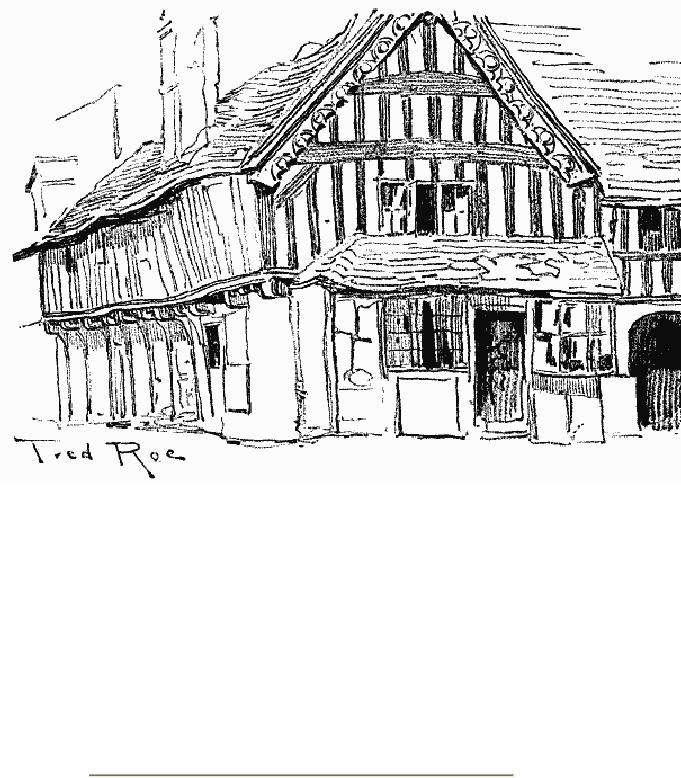
Half-timber
House at Alcester
There is
much in the neighbourhood of
Evesham which is worthy of
note, many old
-fashioned
villages and country towns,
manor-houses, churches, and inns
which are
refreshing
to the eyes of those who
have seen so much
destruction, so much of
the
England
that is vanishing. The old
abbey tithe-barn at Littleton of the
fourteenth
century,
Wickhamford Manor, the home
of Penelope Washington, whose
tomb is in
the
adjoining church, the
picturesque village of Cropthorne,
Winchcombe and its
houses,
Sudeley Castle, the timbered
houses at Norton and Harvington,
Broadway
and
Campden, abounding with beautiful houses,
and the old town of
Alcester, of
which
some views are given--all
these contain many objects
of antiquarian and
artistic
interest, and can easily be
reached from Evesham. In
that old town we
have
seen
much to interest, and the
historian will delight to fight
over again the battle
of
Evesham
and study the records of the
siege of the town in the
Civil War.
CHAPTER
X
OLD
INNS
The
trend of popular legislation is in
the direction of the
diminishing of the
number
of
licensed premises and the
destruction of inns. Very soon, we
may suppose, the
"Black
Boy" and the "Red
Lion" and hosts of other old signs will
have vanished,
and
there will be a very large
number of famous inns which
have "retired from
business."
Already their number is
considerable. In many towns
through which in
olden
days the stage-coaches passed
inns were almost as
plentiful as blackberries;
they
were needed then for
the numerous passengers who
journeyed along the
great
roads
in the coaches; they are
not needed now when people
rush past the places
in
express
trains. Hence the order
has gone forth that these
superfluous houses
shall
cease
to be licensed premises and must
submit to the removal of
their signs. Others
have
been so remodelled in order to
provide modern comforts and
conveniences
that
scarce a trace of their old-fashioned
appearance can be found.
Modern
temperance
legislators imagine that if
they can only reduce the
number of inns they
will
reduce drunkenness and make the English
people a sober nation. This is
not the
place
to discuss whether the
destruction of inns tends to promote
temperance. We
may,
perhaps, be permitted to doubt the
truth of the legend, oft
repeated on
temperance
platforms, of the working
man, returning homewards
from his toil,
struggling
past nineteen inns and
succumbing to the syren
charms of the
twentieth.
We
may fear lest the
gathering together of large
numbers of men in a few
public-
houses
may not increase rather
than diminish their thirst
and the love of good
fellowship
which in some mysterious way
is stimulated by the imbibing of
many
pots
of beer. We may, perhaps, feel
some misgiving with regard to
the temperate
habits
of the people, if instead of well-conducted
hostels, duly inspected by
the
police,
the landlords of which are
liable to prosecution for
improper conduct, we
see
arising a host of ungoverned
clubs, wherein no control is exercised
over the
manners
of the members and adequate
supervision impossible. We cannot
refuse to
listen
to the opinion of certain
royal commissioners who,
after much sifting of
evidence,
came to the conclusion that
as far as the suppression of
public-houses had
gone,
their diminution had not
lessened the convictions for
drunkenness.
But
all this is beside our
subject. We have only to
record another feature
of
vanishing
England, the gradual
disappearance of many of its
ancient and historic
inns,
and to describe some of the
fortunate survivors. Many of
them are very
old,
and
cannot long contend against
the fiery eloquence of the
young temperance
orator,
the newly fledged justice of
the peace, or the budding
member of Parliament
who
tries to win votes by
pulling things down.
We
have, however, still some of
these old hostelries left;
medieval pilgrim inns
redolent
of the memories of the not
very pious companies of men and
women who
wended
their way to visit the
shrines of St. Thomas of
Canterbury or Our Lady
at
Walsingham;
historic inns wherein some
of the great events in the
annals of
England
have occurred; inns
associated with old romances or
frequented by
notorious
highwaymen, or that recall
the adventures of Mr. Pickwick
and other
heroes
and villains of Dickensian tales. It is
well that we should try to
depict some
of
these before they altogether
vanish.
There
was nothing vulgar or disgraceful
about an inn a century ago.
From
Elizabethan
times to the early part of
the nineteenth century they
were frequented
by
most of the leading spirits
of each generation. Archbishop
Leighton, who died in
1684,
often used to say to Bishop
Burnet that "if he were to
choose a place to die in
it
should be an inn; it looked
like a pilgrim's going home,
to whom this world
was
all
as an Inn, and who was weary of
the noise and confusion of it."
His desire was
fulfilled.
He died at the old Bell Inn in
Warwick Lane, London, an old
galleried
hostel
which was not demolished
until 1865. Dr. Johnson,
when delighting in
the
comfort
of the Shakespeare's Head Inn,
between Worcester and
Lichfield,
exclaimed:
"No, sir, there is nothing
which has yet been
contrived by man, by
which
so much happiness is provided as by a
good tavern or inn." This
oft-quoted
saying
the learned Doctor uttered
at the Chapel House Inn,
near King's Norton;
its
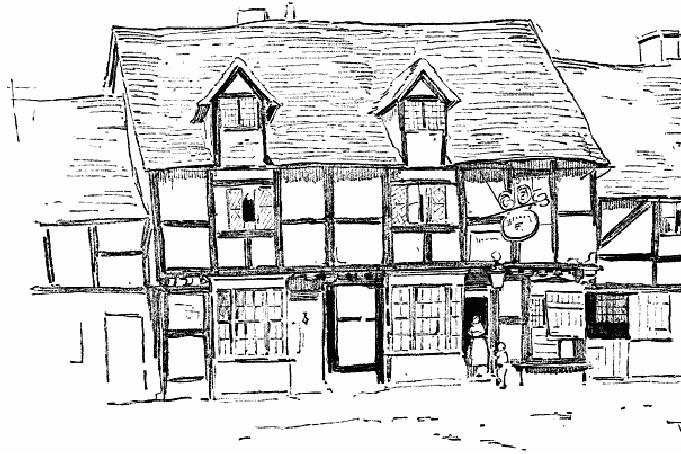
glory
has departed; it is now a simple
country-house by the roadside.
Shakespeare,
who
doubtless had many opportunities of
testing the comforts of the
famous inns at
Southwark,
makes Falstaff say: "Shall I
not take mine ease at mine
inn?"; and
Shenstone
wrote the well-known rhymes
on a window of the old Red
Lion at
Henley-on-Thames:--
Whoe'er
has travelled life's dull
road,
Where'er
his stages may have
been,
May
sigh to think he still has
found
The
warmest welcome at an
inn.
Fynes
Morrison tells of the
comforts of English inns
even as early as the
beginning
of
the seventeenth century. In 1617 he
wrote:--
"The
world affords not such
inns as England hath, for as
soon as a
passenger
comes the servants run to
him; one takes his horse and
walks
him
till he be cold, then rubs
him and gives him meat;
but let the
master
look to this point. Another
gives the traveller his
private
chamber
and kindles his fire, the
third pulls off his boots
and makes
them
clean; then the host or
hostess visits him--if he will
eat with the
host--or
at a common table it will be 4d. and
6d. If a gentleman
has
his
own chamber, his ways
are consulted, and he has
music, too, if he
likes."
The
Wheelwrights' Arms,
Warwick
The
literature of England abounds in references to
these ancient inns. If
Dr.
Johnson,
Addison, and Goldsmith were
alive now, we should find
them chatting
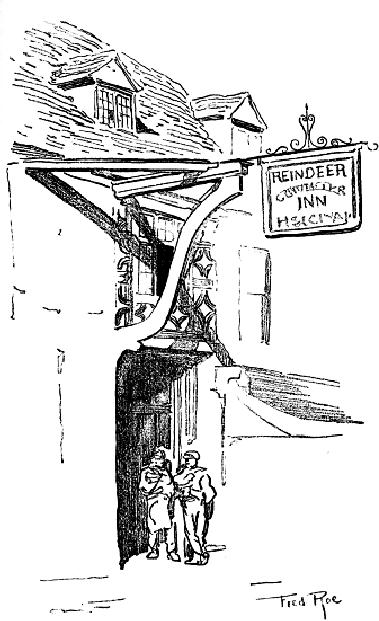
together
at the Authors' Club, or the
Savage, or the Athenĉum.
There were no
literary
clubs in their days, and
the public parlours of the
Cock Tavern or the
"Cheshire
Cheese" were their clubs,
wherein they were quite as
happy, if not quite
so
luxuriously housed, as if they had been
members of a modern social
institution.
Who
has not sung in praise of
inns? Longfellow, in his
Hyperion,
makes Flemming
say:
"He who has not
been at a tavern knows not
what a paradise it is. O
holy
tavern!
O miraculous tavern! Holy,
because no carking cares are
there, nor
weariness,
nor pain; and miraculous,
because of the spits which of
themselves
turned
round and round." They
appealed strongly to Washington
Irving, who, when
recording
his visit to the shrine of
Shakespeare, says: "To a homeless man,
who has
no
spot on this wide world
which he can truly call his
own, there is a
momentary
feeling
of something like independence and
territorial consequence, when after
a
weary
day's travel he kicks off
his boots, thrusts his feet
into slippers, and
stretches
himself
before an inn fire. Let
the world without go as it
may; let kingdoms rise
or
fall,
so long as he has the
wherewithal to pay his bill,
he is, for the time
being, the
very
monarch of all he surveys....
'Shall I not take mine ease
in mine inn?' thought
I,
as I gave the fire a stir,
lolled back in my elbow chair,
and cast a complacent
look
about
the little parlour of the
Red Horse at Stratford-on-Avon."
Entrance
to the Reindeer Inn,
Banbury
And
again, on Christmas Eve Irving
tells of his joyous long
day's ride in a coach,
and
how he at length arrived at a
village where he had determined to
stay the night.
As
he drove into the great
gateway of the inn (some of
them were mighty
narrow
and
required much skill on the
part of the Jehu) he saw on one
side the light of a
rousing
kitchen fire beaming through
a window. He "entered and admired,
for the
hundredth
time, that picture of
convenience, neatness, and broad
honest
enjoyment--the
kitchen of an English inn." It was of
spacious dimensions,
hung
round
with copper and tin vessels
highly polished, and decorated here and
there
with
Christmas green. Hams, tongues,
and flitches of bacon were
suspended from
the
ceiling; a smoke-jack made
its ceaseless clanking
beside the fire-place, and
a
clock
ticked in one corner. A well-scoured deal
table extended along one
side of the
kitchen,
with a cold round of beef and
other hearty viands upon
it, over which
two
foaming
tankards of ale seemed mounting
guard. Travellers of inferior
order were
preparing
to attack this stout repast,
while others sat smoking
and gossiping over
their
ale on two high-backed oaken settles
beside the fire. Trim
housemaids were
hurrying
backwards and forwards under
the directions of a fresh
bustling landlady;
but
still seizing an occasional
moment to exchange a flippant
word, and have a
rallying
laugh with the group
round the fire.
Such
is the cheering picture of an
old-fashioned inn in days of yore. No
wonder that
the
writers should have thus
lauded these inns! Imagine
yourself on the box-seat
of
an
old coach travelling somewhat
slowly through the night. It
is cold and wet, and
your
fingers are frozen, and the
rain drives pitilessly in
your face; and then,
when
you
are nearly dead with
misery, the coach stops at a
well-known inn. A
smiling
host
and buxom hostess greets
you; blazing fires thaw
you back to life, and good
cheer
awaits your appetite. No wonder people
loved an inn and wished to take
their
ease
therein after the dangers
and hardships of the day.
Lord Beaconsfield, in
his
novel
Tancred,
vividly describes the busy
scene at a country hostelry in
the busy
coaching
days. The host, who is
always "smiling," conveys
the pleasing
intelligence
to the passengers: "'The coach
stops here half an hour,
gentlemen:
dinner
quite ready.' 'Tis a
delightful sound. And what a
dinner! What a profusion
of
substantial
delicacies! What mighty and
iris-tinted rounds of beef!
What vast and
marble-veined
ribs! What gelatinous veal
pies! What colossal hams! These
are
evidently
prize cheeses! And how
invigorating is the perfume of those
various and
variegated
pickles. Then the bustle
emulating the plenty; the
ringing of bells, the
clash
of thoroughfare, the summoning of
ubiquitous waiters, and the
all-pervading
feeling
of omnipotence from the guests,
who order what they
please to the
landlord,
who
can produce and execute everything
they can desire. 'Tis a
wondrous sight!"
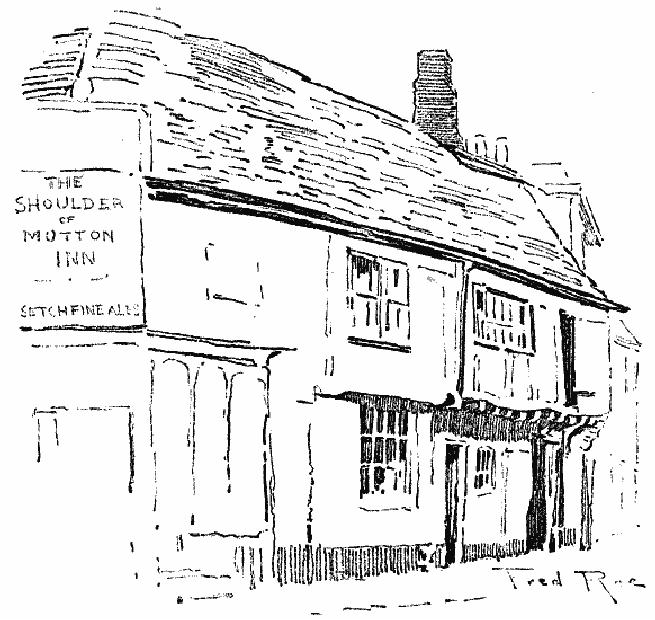
The
Shoulder of Mutton Inn,
King's Lynn
And
then how picturesque these
old inns are, with
their swinging signs, the
pump
and
horse-trough before the
door, a towering elm or
poplar overshadowing the
inn,
and
round it and on each side of
the entrance are seats,
with rustics sitting on
them.
The
old house has picturesque
gables and a tiled roof
mellowed by age, with
moss
and
lichen growing on it, and
the windows are latticed. A
porch protects the
door,
and
over it and up the walls are
growing old-fashioned climbing
rose trees.
Morland
loved to paint the exteriors
of inns quite as much as he
did to frequent
their
interiors, and has left us
many a wondrous drawing of
their beauties. The
interior
is no less picturesque, with
its open ingle-nook, its
high-backed settles, its
brick
floor, its pots and pans,
its pewter and brass
utensils. Our artist has
drawn for
us
many beautiful examples of
old inns, which we shall
visit presently and try
to
learn
something of their old-world
charm. He has only just
been in time to
sketch
them,
as they are fast disappearing. It is
astonishing how many noted
inns in
London
and the suburbs have
vanished during the last
twenty or thirty
years.
Let
us glance at a few of the great
Southwark inns. The old
"Tabard," from which
Chaucer's
pilgrims started on their memorable
journey, was destroyed by a great
fire
in 1676, rebuilt in the old
fashion, and continued until
1875, when it had to
make
way for a modern "old
Tabard" and some hop
merchant's offices. This
and
many
other inns had galleries
running round the yard, or
at one end of it, and this
yard
was a busy place, frequented not
only by travellers in coach or saddle,
but by
poor
players and mountebanks, who
set up their stage for
the entertainment of
spectators
who hung over the
galleries or from their
rooms watched the
performance.
The model of an inn-yard was
the first germ of theatrical
architecture.
The
"White Hart" in Southwark
retained its galleries on
the north and east side
of
its
yard until 1889, though a
modern tavern replaced the
south and main portion
of
the
building in 1865-6. This was
a noted inn, bearing as its
sign a badge of
Richard
II,
derived from his mother
Joan of Kent. Jack Cade
stayed there while he was
trying
to capture London, and another
"immortal" flits across the
stage, Master Sam
Weller,
of Pickwick
fame.
A galleried inn still
remains at Southwark, a great
coaching
and carriers' hostel, the
"George." It is but a fragment of
its former
greatness,
and the present building was erected soon
after the fire in 1676, and
still
retains
its picturesqueness.
The
glory has passed from
most of these London inns.
Formerly their yards
resounded
with the strains of the
merry post-horn, and carriers' carts
were as
plentiful
as omnibuses now are. In the
fine yard of the "Saracen's
Head," Aldgate,
you
can picture the busy scene,
though the building has
ceased to be an inn, and
if
you
wished to travel to Norwich
there you would have
found your coach ready
for
you.
The old "Bell Savage," which
derives its name from one
Savage who kept
the
"Bell
on the Hoop," and not from
any beautiful girl "La
Belle Sauvage," was a great
coaching
centre, and so were the
"Swan with two Necks,"
Lad Lane, the
"Spread
Eagle"
and "Cross Keys" in Gracechurch Street,
the "White Horse," Fetter
Lane,
and
the "Angel," behind St.
Clements. As we do not propose to
linger long in
London,
and prefer the country towns
and villages where relics of
old English life
survive,
we will hie to one of these noted
hostelries, book our seats
on a Phantom
coach,
and haste away from
the great city which has
dealt so mercilessly with
its
ancient
buildings. It is the last
few years which have wrought
the mischief. Many of
these
old inns lingered on till
the 'eighties. Since then
their destruction has
been
rapid,
and the huge caravanserais, the
"Cecil," the "Ritz," the
"Savoy," and the
"Metropole,"
have supplanted the old
Saracen's Heads, the Bulls,
the Bells, and the
Boars
that satisfied the needs of
our forefathers in a less
luxurious age.
Let
us travel first along the
old York road, or rather select
our route, going by
way
of
Ware, Tottenham, Edmonton, and
Waltham Cross, Hatfield and Stevenage,
or
through
Barnet, until we arrive at
the Wheat Sheaf Inn on Alconbury
Hill, past
Little
Stukeley, where the two
roads conjoin and "the
milestones are
numbered
agreeably
to that admeasurement," viz. to
that from Hicks' Hall
through Barnet, as
Patterson's
Roads plainly
informs us. Along this road
you will find several of
the
best
specimens of old coaching
inns in England. The famous
"George" at
Huntingdon,
the picturesque "Fox and
Hounds" at Ware, the grand
old inns at
Stilton
and Grantham are some of the
best inns on English roads,
and pleadingly
invite
a pleasant pilgrimage. We might follow in
the wake of Dick Turpin, if
his
ride
to York were not a myth. The
real incident on which the
story was founded
occurred
about the year 1676,
long before Turpin was born.
One Nicks robbed a
gentleman
on Gadshill at four o'clock in
the morning, crossed the
river with his bay
mare
as soon as he could get a ferry-boat at
Gravesend, and then by
Braintree,
Huntingdon,
and other places reached York
that evening, went to the
Bowling
Green,
pointedly asked the mayor
the time, proved an alibi,
and got off.
This
account
was published as a broadside
about the time of Turpin's
execution, but it
makes
no allusion to him whatever. It
required the romance of the
nineteenth
century
to change Nicks to Turpin and the
bay mare to Black Bess. But
revenir
à
nos
moutons, or rather
our inns. The old
"Fox and Hounds" at Ware is
beautiful
with
its swinging sign suspended
by graceful and elaborate ironwork and
its dormer
windows.
The "George" at Huntingdon
preserves its gallery in the
inn-yard, its
projecting
upper storey, its outdoor
settle, and much else
that is attractive.
Another
"George"
greets us at Stamford, an ancient
hostelry, where Charles I stayed
during
the
Civil War when he was
journeying from Newark to
Huntingdon.
And
then we come to Grantham, famous
for its old inns.
Foremost among them
is
the
"Angel," which dates back to
medieval times. It has a
fine stone front with
two
projecting
bays, an archway with
welcoming doors on either hand, and above
the
arch
is a beautiful little oriel
window, and carved heads and
gargoyles jut out
from
the
stonework. I think that this
charming front was remodelled in
Tudor times, and
judging
from the interior
plaster-work I am of opinion that
the bays were added
in
the
time of Henry VII, the Tudor
rose forming part of the
decoration. The arch
and
gateway
with the oriel are
the oldest parts of the
front, and on each side of
the arch
is
a sculptured head, one representing
Edward III and the other
his queen, Philippa
of
Hainault. The house belonged in
ancient times to the Knights
Templars, where
royal
and other distinguished
travellers were entertained.
King John is said to
have
held
his court here in 1213, and
the old inn witnessed
the passage of the body
of
Eleanor,
the beloved queen of Edward I, as it
was borne to its last
resting-place at
Westminster.
One of the seven Eleanor
crosses stood at Grantham on St.
Peter's
Hill,
but it shared the fate of
many other crosses and was
destroyed by the
troopers
of
Cromwell during the Civil
War. The first floor of
the "Angel" was occupied
by
one
long room, wherein royal
courts were held. It is now
divided into three
separate
rooms.
In this room Richard III
condemned to execution the
Duke of Buckingham,
and
probably here stayed Cromwell in the
early days of his military
career and
wrote
his letter concerning the
first action that made
him famous. We can
imagine
the
silent troopers assembling in
the market-place late in the
evening, and then
marching
out twelve companies strong to wage an
unequal contest against a
large
body
of Royalists. The Grantham
folk had much to say when
the troopers rode back
with
forty-five prisoners besides divers
horses and arms and colours. The
"Angel"
must
have seen all this and
sighed for peace. Grim
troopers paced its
corridors, and
its
stables were full of tired horses.
One owner of the inn at
the beginning of the
eighteenth
century, though he kept a
hostel, liked not
intemperance. His name
was
Michael
Solomon, and he left an
annual charge of 40s. to be paid to the
vicar of the
parish
for preaching a sermon in
the parish church against
the sin of
drunkenness.
The
interior of this ancient
hostelry has been modernized
and fitted with the
comforts
which we modern folk are
accustomed to expect.
Across
the way is the "Angel's"
rival the "George," possibly
identical with the
hospitium
called "Le George" presented
with other property by
Edward IV to his
mother,
the Duchess of York. It lacks
the appearance of age which
clothes the
"Angel"
with dignity, and was
rebuilt with red brick in
the Georgian era.
The
coaches
often called there, and
Charles Dickens stayed the
night and describes it as
one
of the best inns in England.
He tells of Squeers conducting
his new pupils
through
Grantham to Dotheboys Hall, and
how after leaving the
inn the luckless
travellers
"wrapped themselves more
closely in their coats and
cloaks ... and
prepared
with many half-suppressed moans again to
encounter the piercing
blasts
which
swept across the open
country." At the "Saracen's
Head" in Westgate Isaac
Newton
used to stay, and there are
many other inns, the
majority of which
rejoice
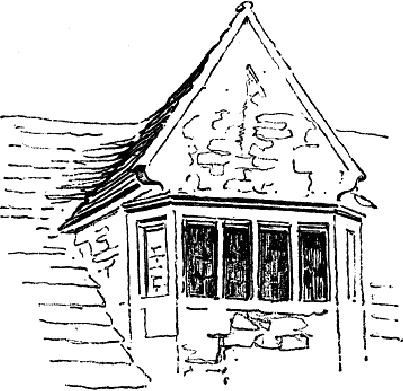
in
signs that are blue. We see
a Blue Horse, a Blue Dog, a
Blue Ram, Blue
Lion,
Blue
Cow, Blue Sheep, and many
other cerulean animals and
objects, which
proclaim
the political colour of the
great landowner. Grantham boasts of a
unique
inn-sign.
Originally known as the
"Bee-hive," a little public-house in
Castlegate has
earned
the designation of the
"Living Sign," on account of
the hive of bees fixed
in
a
tree that guards its portals.
Upon the swinging sign
the following lines
are
inscribed:--
Stop,
traveller, this wondrous
sign explore,
And
say when thou hast viewed it
o'er and o'er,
Grantham,
now two rarities are
thine--
A
lofty steeple and a "Living
Sign."
The
connexion of the "George"
with Charles Dickens reminds
one of the numerous
inns
immortalized by the great novelist
both in and out of London.
The "Golden
Cross"
at Charing Cross, the "Bull" at
Rochester, the "Belle Sauvage"
(now
demolished)
near Ludgate Hill, the
"Angel" at Bury St. Edmunds,
the "Great White
Horse"
at Ipswich, the "King's
Head" at Chigwell (the
original of the "Maypole"
in
Barnaby
Rudge), the
"Leather Bottle" at Cobham
are only a few of those
which he
by
his writings made
famous.
A
Quaint Gable. The Bell
Inn, Stilton
Leaving
Grantham and its inns, we
push along the great North
Road to Stilton,
famous
for its cheese, where a
choice of inns awaits
us--the "Bell" and
the
"Angel,"
that glare at each other
across the broad thoroughfare. In
the palmy days
of
coaching the "Angel" had
stabling for three hundred
horses, and it was kept by
Mistress
Worthington, at whose door
the famous cheeses were
sold and hence
called
Stilton, though they were
made in distant farmsteads and villages.
It is quite
a
modern-looking inn as compared with
the "Bell." You can see a
date inscribed on
one
of the gables, 1649, but
this can only mean that
the inn was restored then,
as
the
style of architecture of "this dream in
stone" shows that it must
date back to
early
Tudor times. It has a noble
swinging sign supported by
beautifully designed
ornamental
ironwork, gables, bay-windows, a Tudor
archway, tiled roof, and
a
picturesque
courtyard, the silence and
dilapidation of which are
strangely
contrasted
with the continuous bustle,
life, and animation which
must have existed
there
before the era of
railways.
Not
far away is Southwell, where
there is the historic inn
the "Saracen's Head."
Here
Charles I stayed, and you can see
the very room where he
lodged on the left of
the
entrance-gate. Here it was on
May 5th, 1646, that he gave
himself up to the
Scotch
Commissioners, who wrote to
the Parliament from
Southwell "that it
made
them
feel like men in a dream."
The "Martyr-King" entered this
inn as a sovereign;
he
left it a prisoner under the
guard of his Lothian escort.
Here he slept his
last
night
of liberty, and as he passed under
the archway of the
"Saracen's Head" he
started
on that fatal journey that
terminated on the scaffold at
Whitehall. You can
see
on the front of the inn
over the gateway a stone
lozenge with the royal
arms
engraved
on it with the date 1693,
commemorating this royal
melancholy visit. In
later
times Lord Byron was a
frequent visitor.
On
the high, wind-swept road
between Ashbourne and Buxton
there is an inn which
can
defy the attacks of the
reformers. It is called the
Newhaven Inn and was
built
by
a Duke of Devonshire for the
accommodation of visitors to Buxton.
King
George
IV was so pleased with it that he gave
the Duke a perpetual
licence, with
which
no Brewster Sessions can interfere.
Near Buxton is the second
highest inn in
England,
the "Cat and Fiddle," and
"The Traveller's Rest" at
Flash Bar, on the
Leek
road,
ranks as third, the highest
being the Tan Hill Inn, near
Brough, on the
Yorkshire
moors.
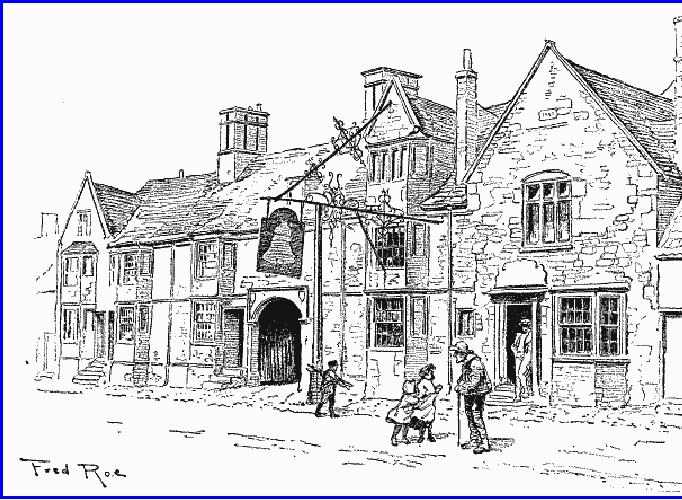
The
Bell Inn, Stilton
Norwich
is a city remarkable for its
old buildings and famous
inns. A very ancient
inn
is the "Maid's Head" at
Norwich, a famous hostelry
which can vie in
interest
with
any in the kingdom. Do we
not see there the
identical room in which
good
Queen
Bess is said to have reposed
on the occasion of her visit to
the city in 1578?
You
cannot imagine a more
delightful old chamber, with
its massive beams,
its
wide
fifteenth-century fire-place, and its
quaint lattice, through
which the
moonbeams
play upon antique furniture
and strange, fantastic carvings. This
oak-
panelled
room recalls memories of the
Orfords, Walpoles, Howards,
Wodehouses,
and
other distinguished guests
whose names live in
England's annals. The old
inn
was
once known as the Murtel or
Molde Fish, and some have
tried to connect the
change
of name with the visit of
Queen Elizabeth; unfortunately
for the conjecture,
the
inn was known as the Maid's
Head long before the days of
Queen Bess. It was
built
on the site of an old bishop's palace, and in
the cellars may be seen
some
traces
of Norman masonry. One of
the most fruitful sources of
information about
social
life in the fifteenth
century are the Paston
Letters. In one
written by John
Paston
in 1472 to "Mestresse Margret Paston," he tells
her of the arrival of a
visitor,
and
continues: "I praye yow make
hym goode cheer ... it were
best to sette hys
horse
at the Maydes Hedde, and I shall be
content for ther expenses."
During the
Civil
War this inn was the
rendezvous of the Royalists,
but alas! one day
Cromwell's
soldiers made an attack on
the "Maid's Head," and took
for their prize
the
horses of Dame Paston stabled
here.
We
must pass over the records
of civic feasts and aldermanic
junketings, which
would
fill a volume, and seek out
the old "Briton's Arms," in
the same city, a
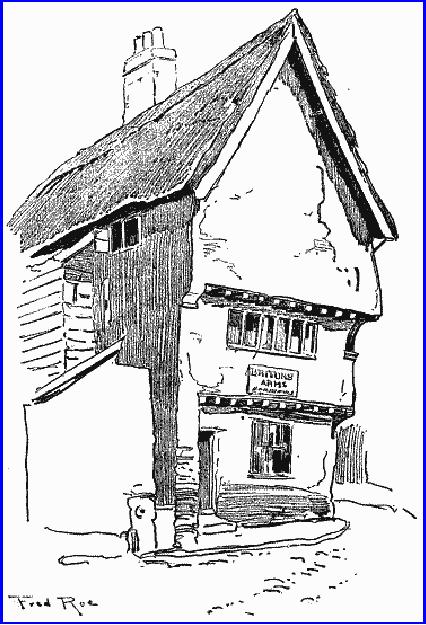
thatched
building of venerable appearance
with its projecting upper
storeys and
lofty
gable. It looks as if it may not
long survive the march of
progress.
The
parish of Heigham, now part
of the city of Norwich, is
noted as having been
the
residence of Bishop Hall,
"the English Seneca," and
author of the Meditations,
on
his ejection from the
bishopric in 1647 till his death in
165643
The house
in
which
he resided, now known as the
Dolphin Inn, still stands, and is an
interesting
building
with its picturesque bays and
mullioned windows and ingeniously
devised
porch.
It has actually been
proposed to pull down, or
improve out of existence,
this
magnificent
old house. Its front is a
perfect specimen of flint and stone
sixteenth-
century
architecture. Over the main
door appears an episcopal coat of arms
with the
date
1587, while higher on the
front appears the date of a
restoration (in two
bays):
--
The
"Briton's Arms, "
Norwich
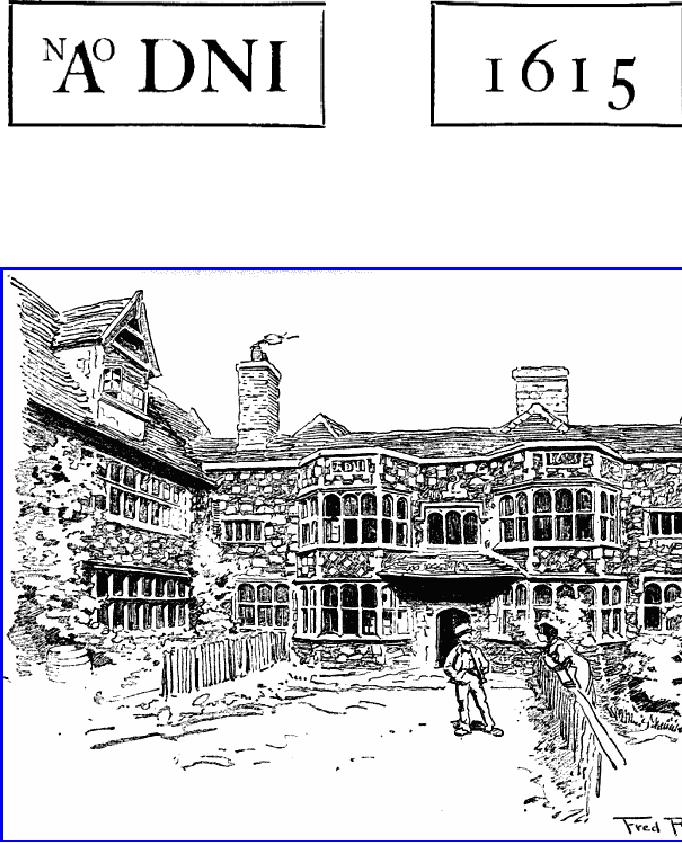
Just
inside the doorway is a fine
Gothic stoup into which
bucolic rustics now
knock
the
fag-ends of their pipes. The
staircase newel is a fine
piece of Gothic
carving
with
an embattled moulding, a poppy-head
and heraldic lion. Pillared
fire-places
and
other tokens of departed
greatness testify to the
former beauty of this
old
dwelling-place.
The
Dolphin Inn, Heigham,
Norwich
We
will now start back to town by
the coach which leaves the
"Maid's Head" (or
did
leave in 1762) at half-past
eleven in the forenoon, and hope to
arrive in London
on
the following day, and
thence hasten southward to Canterbury.
Along this Dover
road
are some of the best
inns in England: the "Bull"
at Dartford, with its
galleried
courtyard,
once a pilgrims' hostel; the
"Bull" and "Victoria" at
Rochester,
reminiscent
of Pickwick;
the modern "Crown" that
supplants a venerable inn
where
Henry
VIII first beheld Anne of
Cleves; the "White Hart";
and the "George,"
where
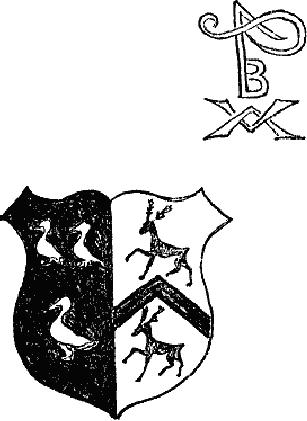
pilgrims
stayed; and so on to Canterbury, a city
of memories, which happily
retains
many
features of old English life
that have not altogether
vanished. Its grand
cathedral,
its churches, St.
Augustine's College, its
quaint streets, like
Butchery
Lane,
with their houses bending
forward in a friendly manner to
almost meet each
other,
as well as its old inns,
like the "Falstaff" in High
Street, near West
Gate,
standing
on the site of a pilgrims' inn,
with its sign showing
the valiant and
portly
knight,
and supported by elaborate ironwork, its
tiled roof and picturesque
front, all
combine
to make Canterbury as charming a place of
modern pilgrimage as it
was
attractive
to the pilgrims of another
sort who frequented its
inns in days of yore.
Shield
and Monogram on doorway of the
Dolphin Inn, Heigham
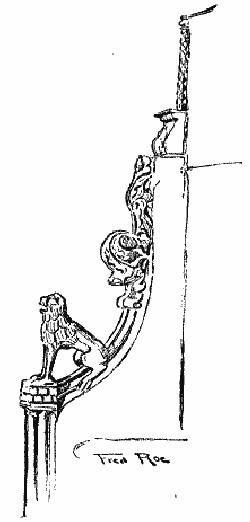
Staircase
Newel at the Dolphin Inn.
From Old
Oak Furniture, by Fred
Roe
And
now we will discard the cumbersome old
coaches and even the
"Flying
Machines,"
and travel by another flying
machine, an airship, landing
where we
will,
wherever a pleasing inn
attracts us. At Glastonbury is
the famous "George,"
which
has hardly changed its
exterior since it was built by Abbot
Selwood in 1475
for
the accommodation of middle-class
pilgrims, those of high degree
being
entertained
at the abbot's lodgings. At
Gloucester we find ourselves in
the midst of
memories
of Roman, Saxon, and
monastic days. Here too are
some famous inns,
especially
the quaint "New Inn," in
Northgate Street, a somewhat peculiar
sign for
a
hostelry built (so it is said) for
the use of pilgrims
frequenting the shrine
of
Edward
II in the cathedral. It retains
all its ancient medieval
picturesqueness. Here
the
old gallery which surrounded
most of our inn-yards
remains. Carved beams
and
door-posts
made of chestnut are seen
everywhere, and at the corner of
New Inn
Lane
is a very elaborate sculpture, the
lower part of which
represents the Virgin
and
Holy Child. Here, in Hare
Lane, is also a similar inn,
the Old Raven
Tavern,
which
has suffered much in the
course of ages. It was formerly built
around a
courtyard,
but only one side of it is
left.
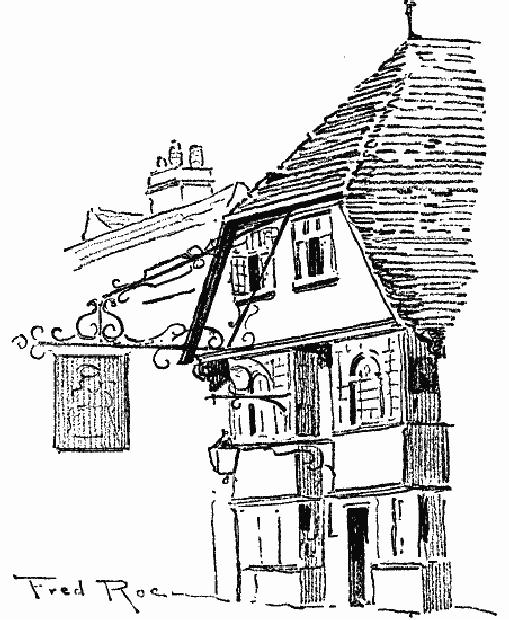
The
Falstaff Inn,
Canterbury
There
are many fine examples of
old houses that are
not inns in
Gloucester,
beautiful
half-timbered black and white
structures, such as Robert
Raikes's house,
the
printer who has the
credit of founding the first
Sunday-school, the old
Judges'
House
in Westgate Street, the old
Deanery with its Norman
room, once the
Prior's
Lodge
of the Benedictine Abbey.
Behind many a modern front
there exist curious
carvings
and quaintly panelled rooms
and elaborate ceilings. There is an
interesting
carved-panel
room in the Tudor House,
Westgate Street. The panels are of
the linen
-fold
pattern, and at the head of
each are various designs,
such as the Tudor
Rose
and
Pomegranate, the Lion of England,
etc. The house originally
known as the Old
Blue
Shop has some magnificent
mantelpieces, and also St. Nicholas
House can
boast
of a very elaborately carved
example of Elizabethan
sculpture.
We
journey thence to Tewkesbury and
visit the grand silver-grey
abbey that adorns
the
Severn banks. Here are
some good inns of great
antiquity. The "Wheat-sheaf"
is
perhaps
the most attractive, with
its curious gable and
ancient lights, and even
the
interior
is not much altered. Here
too is the "Bell," under
the shadow of the
abbey
tower.
It is the original of Phineas
Fletcher's house in the novel
John
Halifax,
Gentleman.
The "Bear and the Ragged
Staff" is another half-timbered house
with a
straggling
array of buildings and
curious swinging signboard,
the favourite haunt
of
the
disciples of Izaak Walton,
under the overhanging eaves
of which the Avon
silently
flows.
The
old "Seven Stars" at Manchester is
said to be the most ancient
in England,
claiming
a licence 563 years old. But it
has many rivals, such as
the "Fighting
Cocks"
at St. Albans, the "Dick
Whittington" in Cloth Fair,
St. Bartholomews, the
"Running
Horse" at Leatherhead, wherein
John Skelton, the poet
laureate of Henry
VIII,
sang the praises of its
landlady, Eleanor Rumming, and
several others. The
"Seven
Stars" has many interesting features
and historical associations. Here
came
Guy
Fawkes and concealed himself in "Ye Guy
Faux Chamber," as the legend
over
the
door testifies. What strange stories
could this old inn
tell us! It could tell us
of
the
Flemish weavers who, driven
from their own country by
religious persecutions
and
the atrocities of Duke Alva,
settled in Manchester in 1564, and
drank many a
cup
of sack at the "Seven
Stars," rejoicing in their
safety. It could tell us of
the
disputes
between the clergy of the
collegiate church and the
citizens in 1574,
when
one
of the preachers, a bachelor of divinity,
on his way to the church was
stabbed
three
times by the dagger of a
Manchester man; and of the
execution of three
popish
priests, whose heads were
afterwards exposed from the
tower of the church.
Then
there is the story of the
famous siege in 1642, when
the King's forces tried
to
take
the town and were repulsed
by the townsfolk, who were
staunch Roundheads.
"A
great and furious skirmish did
ensue," and the "Seven Stars"
was in the centre of
the
fighting. Sir Thomas Fairfax
made Manchester his head-quarters in
1643, and
the
walls of the "Seven Stars"
echoed with the carousals of
the Roundheads. When
Fairfax
marched from Manchester to
relieve Nantwich, some dragoons had to
leave
hurriedly,
and secreted their mess
plate in the walls of the
old inn, where it was
discovered
only a few years ago, and
may now be seen in the
parlour of this
interesting
hostel. In 1745 it furnished
accommodation for the
soldiers of Prince
Charles
Edward, the Young Pretender,
and was the head-quarters of
the Manchester
regiment.
One of the rooms is called
"Ye Vestry," on account of its
connexion with
the
collegiate church. It is said
that there was a secret
passage between the inn
and
the
church, and, according to
the Court Leet Records, some
of the clergy used to
go
to
the "Seven Stars" in sermon-time in
their surplices to refresh
themselves. O
tempora!
O mores! A horseshoe
at the foot of the stairs
has a story to tell.
During
the
war with France in 1805 the
press-gang was billeted at the
"Seven Stars." A
young
farmer's lad was leading a horse to be
shod which had cast a shoe. The
press-
gang
rushed out, seized the
young man, and led him
off to serve the king.
Before
leaving
he nailed the shoe to a post on
the stairs, saying, "Let
this stay till I come
from
the wars to claim it." So it
remains to this day
unclaimed, a mute reminder
of
its
owner's fate and of the
manners of our
forefathers.
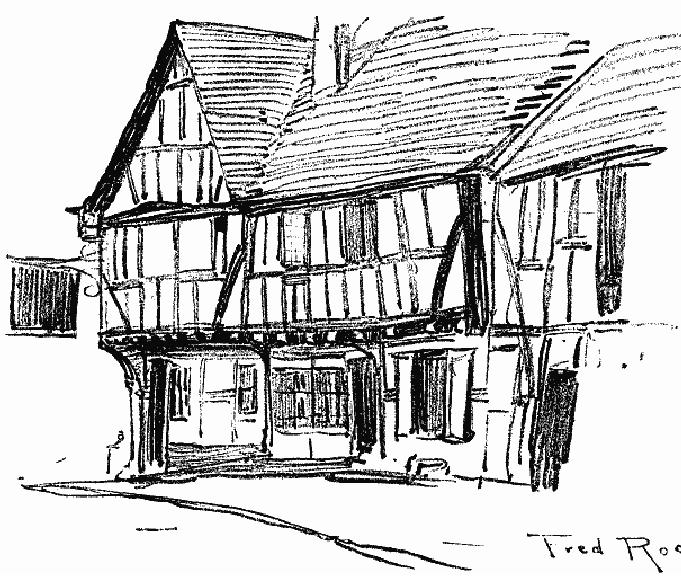
The
Bear and Ragged Staff Inn,
Tewkesbury
Another
inn, the "Fighting Cocks" at
St. Albans, formerly known
as "Ye Old
Round
House," close to the River
Ver, claims to be the oldest
inhabited house in
England.
It probably formed part of
the monastic buildings, but
its antiquity as an
inn
is not, as far as I am aware, fully
established.
The
antiquary must not forget
the ancient inn at
Bainbridge, in Wensleydale,
which
has
had its licence since 1445, and
plays its little part in
Drunken
Barnaby's
Journal.
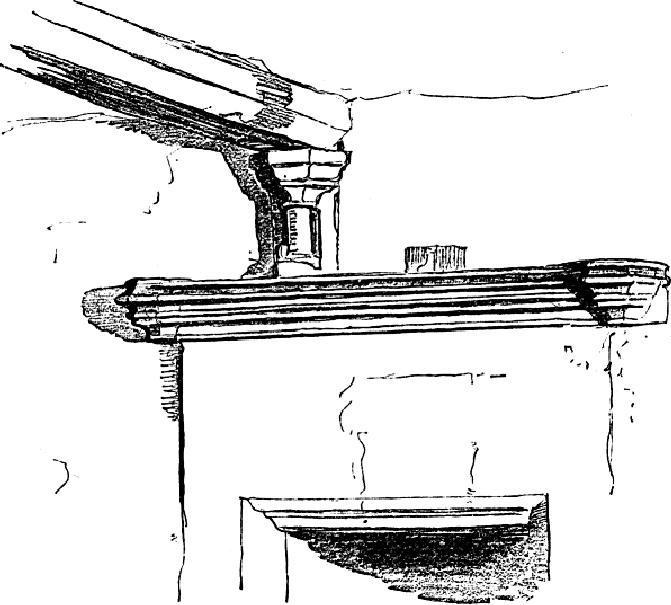
Fire-place
in the George Inn, Norton
St. Philip, Somerset
Many
inns have played an
important part in national
events. There is the "Bull"
at
Coventry,
where Henry VII stayed before
the battle of Bosworth
Field, where he
won
for himself the English
crown. There Mary Queen of
Scots was detained by
order
of Elizabeth. There the
conspirators of the Gunpowder
Plot met to devise
their
scheme for blowing up the
Houses of Parliament. The George Inn at
Norton
St.
Philip, Somerset, took part in
the Monmouth rebellion.
There the Duke
stayed,
and
there was much excitement in
the inn when he informed
his officers that it
was
his
intention to attack Bristol.
Thence he marched with his
rude levies to
Keynsham,
and after a defeat and a vain visit to
Bath he returned to the
"George"
and
won a victory over Faversham's advanced
guard. You can still see
the
Monmouth
room in the inn with
its fine fire-place.
The
Crown and Treaty Inn at Uxbridge
reminds one of the meeting of
the
Commissioners
of King and Parliament, who
vainly tried to arrange a peace
in
1645;
and at the "Bear," Hungerford,
William of Orange received
the
Commissioners
of James II, and set out
thence on his march towards
London and
the
English throne.
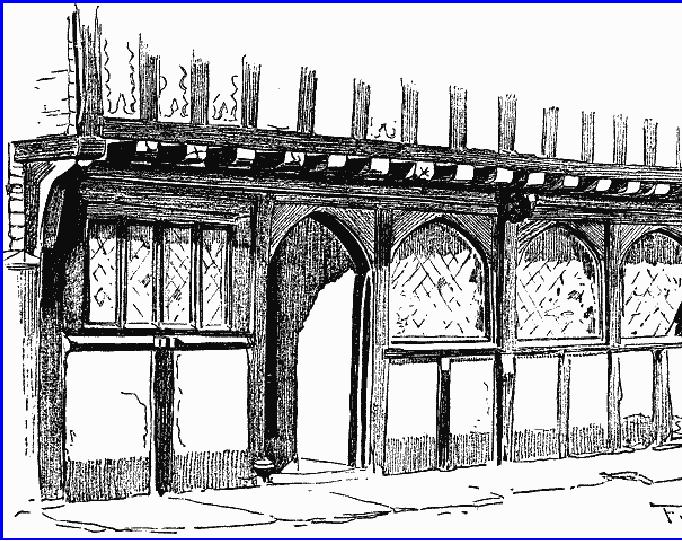
The
Dark Lantern Inn at Aylesbury, in a nest
of poor houses, seems to tell by
its
unique
sign of plots and conspiracies.
Aylesbury
is noted for its inns.
The famous "White Hart" is
no more. It has
vanished
entirely, having disappeared in
1863. It had been modernized,
but could
boast
of a timber balcony round
the courtyard, ornamented
with ancient wood
carvings
brought from Salden House, an
old seat of the Fortescues, near
Winslow.
Part
of the inn was built by
the Earl of Rochester in
1663, and many were
the great
feasts
and civic banquets that took place
within its hospitable doors.
The "King's
Head"
dates from the middle of
the fifteenth century and is a good
specimen of the
domestic
architecture of the Tudor
period. It formerly issued
its own tokens. It
was
probably
the hall of some guild or
fraternity. In a large window
are the arms of
England
and Anjou. The George Inn has
some interesting paintings
which were
probably
brought from Eythrope House
on its demolition in 1810, and
the "Bull's
Head"
has some fine beams and
panelling.
The
Green Dragon Inn, Wymondham,
Norfolk
Some
of the inns of Burford and
Shrewsbury we have seen when
we visited those
old-world
towns. Wymondham, once famous
for its abbey, is noted
for its "Green
Dragon,"
a beautiful half-timbered house with
projecting storeys, and in
our
wanderings
we must not forget to see
along the Brighton road the
picturesque
"Star"
at Alfriston with its three
oriel windows, one of the
oldest in Sussex. It was
once
a sanctuary within the
jurisdiction of the Abbot of
Battle for persons
flying
from
justice. Hither came
men-slayers, thieves, and rogues of every
description,
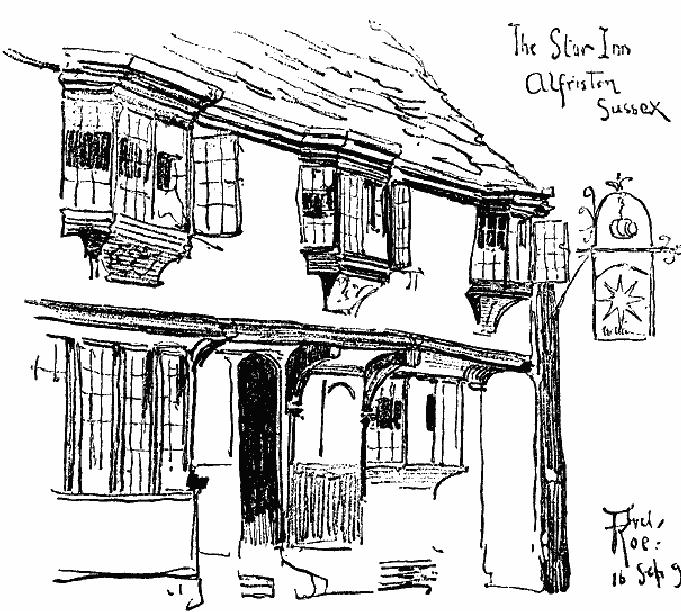
and
if they reached this
inn-door they were safe.
There is a record of a
horse-thief
named
Birrel in the days of Henry VIII seeking
refuge here for a crime
committed
at
Lydd, in Kent. It was
intended originally as a house for
the refreshment of
mendicant
friars. The house is very
quaint with its curious
carvings, including a
great
red lion that guards the side,
the figure-head of a wrecked
Dutch vessel lost in
Cuckmen
Haven. Alfriston was noted
as a great nest of smugglers, and the
"Star"
was
often frequented by Stanton
Collins and his gang, who
struck terror into
their
neighbours,
daringly carried on their
trade, and drank deep at the
inn when the
kegs
were
safely housed. Only fourteen
years ago the last of his
gang died in Eastbourne
Workhouse.
Smuggling is a vanished profession
nowadays, a feature of
vanished
England
that no one would seek to
revive. Who can tell whether
it may not be as
prevalent
as ever it was, if tariff
reform and the imposition of
heavy taxes on
imports
become articles of our
political creed?
The
Star Inn, Afriston
Sussex.
Many
of the inns once famous in
the annals of the road have
now "retired from
business"
and have taken down their
signs. The First and
Last Inn, at Croscombe,
Somerset,
was once a noted coaching
hostel, but since coaches
ceased to run it was
not
wanted and has closed its
doors to the public. Small
towns like Hounslow,
Wycombe,
and Ashbourne were full of important
inns which, being no
longer
required
for the accommodation of
travellers, have retired
from work and
converted
themselves
into private houses. Small
villages like Little
Brickhill, which
happened
to
be a stage, abounded with hostels
which the ending of the
coaching age made
unnecessary.
The Castle Inn at Marlborough, once one of
the finest in England,
is
now
part of a great public school.
The house has a noted
history. It was once a
nobleman's
mansion, being the home of
Frances Countess of Hereford, the
patron
of
Thomson, and then of the
Duke of Northumberland, who
leased it to Mr.
Cotterell
for the purpose of an inn.
Crowds of distinguished folk
have thronged its
rooms
and corridors, including the great
Lord Chatham, who was laid
up here with
an
attack of gout for seven weeks in 1762
and made all the
inn-servants wear his
livery.
Mr. Stanley Weyman has made
it the scene of one of his
charming
romances.
It was not until 1843 that it
took down its sign, and
has since patiently
listened
to the conjugation of Greek and
Latin verbs, to classic lore, and
other
studies
which have made Marlborough
College one of the great and
successful
public
schools. Another great inn was
the fine Georgian house near one of
the
entrances
to Kedleston Park, built by Lord
Scarsdale for visitors to
the medicinal
waters
in his park. But these
waters have now ceased to
cure the mildest
invalid,
and
the inn is now a large
farm-house with vast stables
and barns.
It
seems as if something of the
foundations of history were
crumbling to read
that
the
"Star and Garter" at Richmond is to be
sold at auction. That is a
melancholy
fate
for perhaps the most
famous inn in the country--a
place at which princes and
statesmen
have stayed, and to which
Louis Philippe and his Queen
resorted. The
"Star
and Garter" has figured in
the romances of some of our
greatest novelists.
One
comes across it in Meredith and
Thackeray, and it finds its
way into numerous
memoirs,
nearly always with some
comment upon its unique
beauty of situation, a
beauty
that was never more real
than at this moment when
the spring foliage is
just
beginning
to peep.
The
motor and changing habits
account for the evil days
upon which the
hostelry
has
fallen. Trains and trams
have brought to the doors
almost of the "Star
and
Garter"
a public that has not
the means to make use of its
120 bedrooms. The richer
patrons
of other days flash past on
their motors, making for
those resorts higher up
the
river which are filling
the place in the economy of
the London Sunday and
week-end
which Richmond occupied in
times when travelling was
more difficult.
These
changes are inevitable. The
"Ship" at Greenwich has
gone, and Cabinet
Ministers
can no longer dine there.
The convalescent home, which
was the undoing
of
certain Poplar Guardians, is housed in an
hotel as famous as the
"Ship," in its
days
once the resort of Pitt and
his bosom friends. Indeed, a
pathetic history
might
be
written of the famous
hostelries of the
past.
Not
far from Marlborough is
Devizes, formerly a great coaching
centre, and full of
inns,
of which the most noted is
the "Bear," still a thriving
hostel, once the home
of
the
great artist Sir Thomas
Lawrence, whose father was
the landlord.
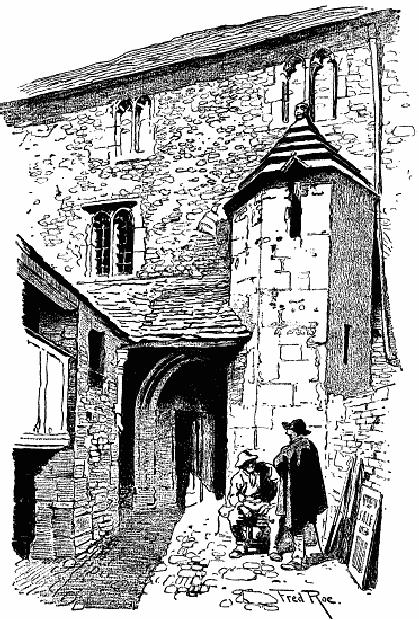
Courtyard
of the George Inn, Norton
St. Philip Somerset
It
is impossible within one chapter to
record all the old
inns of England, we
have
still
a vast number left
unchronicled, but perhaps a
sufficient number of
examples
has
been given of this important
feature of vanishing England.
Some of these are
old
and crumbling, and may die of old
age. Others will fall a prey
to licensing
committees.
Some have been left
high and dry, deserted by
the stream of guests
that
flowed
to them in the old coaching
days. Motor-cars have resuscitated some
and
brought
prosperity and life to the
old guest-haunted chambers. We cannot
dwell on
the
curious signs that greet us as we travel
along the old highways, or
strive to
interpret
their origin and meaning. We
are rather fond in Berkshire
of the "Five
Alls,"
the interpretation of which is
cryptic. The Five Alls
are, if I remember
right--
"I
rule all" [the
king].
"I
pray for all" [the
bishop].
"I
plead for all" [the
barrister].
"I
fight for all" [the
soldier].
"I
pay for all" [the
farmer].
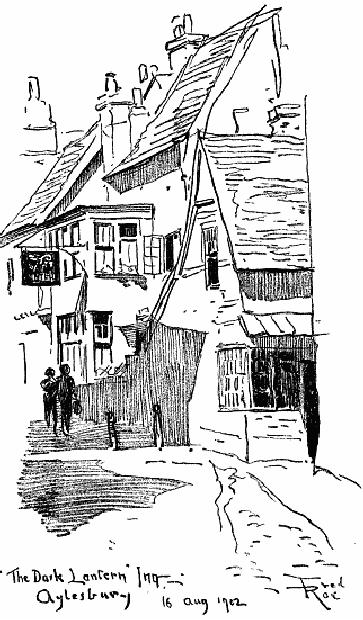
One
of the most humorous inn
signs is "The Man Loaded with
Mischief," which is
found
about a mile from Cambridge,
on the Madingley road. The
original Mischief
was
designed by Hogarth for a
public-house in Oxford Street. It is
needless to say
that
the signboard, and even the
name, have long ago
disappeared from the
busy
London
thoroughfare, but the quaint
device must have been
extensively copied by
country
sign-painters. There is a "Mischief" at
Wallingford, and a "Load of
Mischief"
at Norwich, and another at Blewbury.
The inn on the Madingley
road
exhibits
the sign in its original
form. Though the colours
are much faded from
exposure
to the weather, traces of
Hogarthian humour can be detected. A man
is
staggering
under the weight of a woman,
who is on his back. She is
holding a glass
of
gin in her hand; a chain and
padlock are round the man's
neck, labelled
"Wedlock."
On the right-hand side is
the shop of "S. Gripe,
Pawnbroker," and a
carpenter
is just going in to pledge his
tools.
"The
Dark Lantern" Inn,
Aylesbury
The
art of painting signboards is almost
lost, and when they
have to be renewed
sorry
attempts are made to imitate
the old designs. Some celebrated
artists have not
thought
it below their dignity to
paint signboards. Some have done
this to show
their
gratitude to their kindly
host and hostess for favours
received when
they
Table of Contents:
- INTRODUCTION
- THE DISAPPEARANCE OF ENGLAND
- OLD WALLED TOWNS
- IN STREETS AND LANES
- OLD CASTLES
- VANISHING OR VANISHED CHURCHES
- OLD MANSIONS
- THE DESTRUCTION OF PREHISTORIC REMAINS
- CATHEDRAL CITIES AND ABBEY TOWNS
- OLD INNS
- OLD MUNICIPAL BUILDINGS
- OLD CROSSES
- STOCKS AND WHIPPING-POSTS
- OLD BRIDGES
- OLD HOSPITALS AND ALMSHOUSES
- VANISHING FAIRS
- THE DISAPPEARANCE OF OLD DOCUMENTS
- OLD CUSTOMS THAT ARE VANISHING
- THE VANISHING OF ENGLISH SCENERY
- CONCLUSION